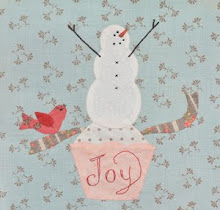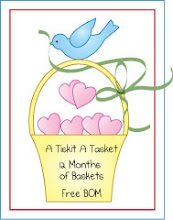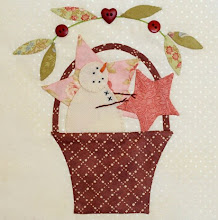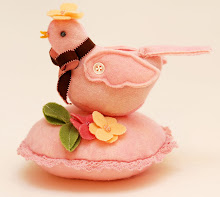Here we go, we’re on our way to stitching together!
Make a little practice piece to try the stem and backstitch with different types of threads.
Cut a scrap of cotton for the background fabric. Cut a piece of flannel or fusible interfacing the same size. (I cut my flannel a tiny bit larger so you could see it in the photo below). 
Put your sampler into a hoop and you’re ready to practice stitching.
Now let’s pick some thread!
Floss
I use DMC embroidery floss or Weeks Dye Works floss, two strands. Some designs call for 2 strands and some call for 3 strands of floss. It’s a combination of personal preference, the stitch being used, background fabric and the floss.
When I outline with a back stitch I like the look of three strands. Try it on your sampler and see what you like best!
Pearl Cotton
I love Valdani pearl cotton and I use size 12 for most of my stitching, but try the Valdani size 8 on a back stitch. You may love the look!
The higher the number the thinner the thread will be. Size 12 is thinner than size 8.
Here’s where it gets a little confusing…Valdani is a thicker thread than DMC. In the picture below DMC is on the left and Valdani is on the right, both size 8.
Valdani size 12 is about the same as DMC size 8. If a pattern calls for Valdani/12 you can substitute with a DMC/8, Valdani/8, substitute DMC /5. DMC size 12 is a thin pearl cotton, beautiful for fine embroidery.
Stem or Outline stitch
This is my favorite stitch and I use it for almost everything. I love the way it gracefully twists, and fills in a line. There are a few secrets to getting this “graceful” stitch.
Use two strands of embroidery floss. The first stitch is a little different from the rest: Start at the beginning of a line and work from left to right. Come up at the start and go down 1/4” away coming up in-between where you came up and went down. Always keep your thread below the needle as shown in the diagram above.
Look carefully at the stem stitch diagram above. Most people make the mistake of going down directly on the traced line. Instead, go down next to the line and come up next to your last stitch, on the other side of the line. You are following the line, but never actually “on” the line. The stem stitch is always done at an angle.
Make the stitches 1/8” in size. If your stitches are too large you’ll have trouble on the curves following the line. Keep the stitches tiny and consistent. If you can sew with 1/4” seam you can embroider with 1/8” stitch!
Back Stitch
The backstitch is my second favorite stitch. Try this stitch with two and then three strands of floss. Work from right to left, following diagram above.
Start your backstitch as shown in the picture below. Come up 1/8” from the start of the line. Go down at the start and come up again 1/8” from where you first came up.
Keep your stitches between 1/8” and 1/4” long. The length of the stitch depends on the floss or pearl cotton you’ve selected. As a general rule I keep my backstitch just a bit over 1/8”.
If you master the stem and backstitch you’ll be on your way to many happy hours of embroidery. It’s so much fun!
I’ll join you in front of the TV!
Hugs,
















